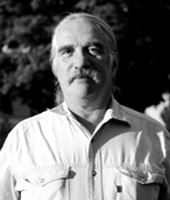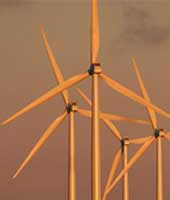 Bob Gough, Intertribal COUP (Council on Utility Policy)
Bob Gough, Intertribal COUP (Council on Utility Policy)
Until drought came to the northern Great Plains, hydropower had long been that region's predominant source of
electrical-generating fuel for residents and industries from Wyoming east through the Dakotas. With dam-fed
power production down these days due to extended drought (and aggravated by climate change), lignite-coal power
plants now account for more than 80% of fuel produced in the region. "Lignite is basically dirt," says
Bob Gough, secretary of Intertribal COUP (Council on Utility Policy), a tribal power collective working to develop
one of the region's most abundant resources, wind power, and to do so on tribal lands. "They're burning
dirt."
To help address the impacts of dirty-coal-a power source that fouls the air and contributes to global warming-fourteen
tribes are presently allied with the I-COUP wind-power cooperative in developing and installing wind turbines on
tribal lands. The organization has already facilitated the development of three major wind turbines on Great
Plains-area reservations, and several smaller projects are in the works. In addition, I-COUP is working with the
Western Area Power Administration (WAPA) on a major study examining how wind-generated electricity might best be
injected into the regional power grid.
I-COUP was established in 1994 to facilitate tribal discussion and input on energy regulatory and economic issues.
The various wind projects it supports are funded by the tribes; private interests; federal agencies, including
the U.S. Dept. of Energy and USDA Rural Utilities Services; and through fundraising support from non-governmental
groups such as Winona LaDuke's non-profit organization, Honor the Earth.
Wind is the world's fastest-growing renewable power resource. Beyond the cost of turbine installations (slightly
more than the cost of a coal plant), the "fuel" for wind-power electrical generation is free for decades,
whereas coal-burners require constant fuel purchases. Blowing some 40% of the time at speeds ranging from about 14
to 24 miles per hour, northern Great Plains wind is uniquely suitable for wind-power generation.
Ironically, that unrelenting wind was once considered a curse by Euro-American farmer-colonists, who claimed much
of the fertile bottomland, leaving the windy uplands largely to area tribes. Those tribes now stand to benefit in
terms of jobs, economic-development potential, and clean, locally produced power that contributes to a crucial
worldwide effort: eliminating climate-changing fossil fuel as a source of energy.
The largest I-COUP-supported project now underway, completed in 2003, is located at the Rosebud Sioux Reservation
in South Dakota. There, a 750-kilowatt wind generator towers 47 meters over the land, spinning out power from an
average 18-20 mph flow of wind through its triple-bladed turbine. That turbine provides an average 80% of the
power required to operate the nearby Rosebud Casino and Hotel; excess power is fed into the regional grid, providing
income to the tribe. "Green tags" (renewable-energy certificates) from the project have been sold to
NativeEnergy in Vermont, which resells them to power users across the nation to offset their own grid-powered
energy consumption.
I-COUP takes the long view on the wind projects it supports. Gough says the plan is to enable tribes to generate
3000mW of energy from the wind by 2015. He says spreading the benefits-and risks-of wind power production across
numerous states and tribes is a major part of the plan, for two reasons: wind doesn't blow consistently in one
place all the time, and dumping power into the WAPA grid from just one or a few points creates strains on the
grid system, especially when that power is sporadic, as wind-based energy is. Constructing projects on different
reservations also helps to share the wind-wealth, jobs, and eventually, turbine-manufacturing opportunities,
utilizing as many low-income tribal workers as possible.
I-COUP garnered worldwide recognition for its efforts when it was presented in June of 2007 with a "World
Clean Energy Award" at the traditional "Faktor -4 Festival" in Basil, Switzerland. Seventy
clean-energy projects from around the world were considered for the honors; I-COUP was among nine award winners.
The organization was honored with a special "award for courage" for its work in the face of substantial
economic and social challenges, including the Rosebud Tribe's location in a county that has consistently been
among the nation's poorest.
I-COUP's efforts serve as a powerful model for tribes and communities looking to reap the benefits of sustainable
energy. Whether it be solar, wind, wave, or biomass, sources of renewable energy that ease the Earth's warming
burden represent important new goals and resources for the tribes. Such alternative energy modes also fit well
with most tribal philosophies, furthering a sustainable, in-balance relationship with the land even as tribal
communities move along the path of economic progress and enjoy the benefits of modernity.
This profile was developed in 2008 by Dennis Wall, Institute for Tribal Environmental Professionals, Northern
Arizona University, with financial support from the U.S. Environmental Protection Agency.
 Bob Gough, Intertribal COUP (Council on Utility Policy)
Bob Gough, Intertribal COUP (Council on Utility Policy)
 Photo courtesy: National Renewable Energy Laboratory
Photo courtesy: National Renewable Energy Laboratory